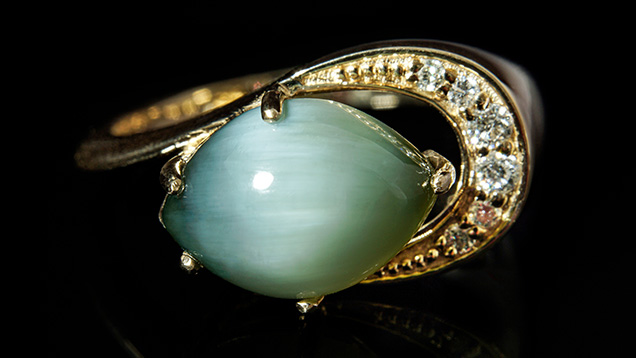Washington Jade Update

At the AGTA show, Rod and Nathaniel Cook of Washington Jade (Edmonds, Washington) told us about shifting their focus to cat’s-eye blue and bluish green nephrite jade (see above). (We first spoke with them in 2019—see Spring 2019 GNI, pp. 124–125.) They initially intended to concentrate on the mid-tier jewelry market, but the non-chatoyant nephrite was not valuable enough to be cost-effective. About two years ago, they saw that two small pieces of chatoyant nephrite were drawing the most attention. This year, they cut 100 chatoyant stones from rough.
“It was a matter of finding something unique to our deposit that was a high enough grade of material that it would have broad market appeal,” Nathaniel said. “People seem to really like not necessarily the really sharp eyes, but the really strong eyes, even if it’s sort of a broad eye that moves across the stone. They’re very charismatic and sort of bold.”
Rod said they find better material each year. “The blue sort of validated the whole operation,” he said. “We have pretty good demand emerging for the rough. Partially because around the world, supplies are down. We hear rumors that Siberia is not producing like it used to, that the surface material is pretty much gone—and going underground is to be avoided.” The host material is also selling very well for high-end lapidary work.
Nathaniel has been cutting the rough since 2019. Orienting it for cutting can be tricky, he said, but understanding how it forms has shown him how to orient and process it. He first locates the line between the two dark sides of the nephrite (the directions where the eye moves back and forth), which he calls the “axis of chatoyance.” Then he starts slabbing the stone parallel to this axis. Some adjustment is required within the slabs to ensure correct orientation of the finished stone. To cut cabochons, he pays attention to the direction of the cat’s-eye and cuts calibrated sizes and shapes either parallel or perpendicular to that alignment.
Nathaniel explained that the material requires slightly different tools than most lapidaries use because of its variable hardness: The ends of the axis of chatoyance are very hard, but around it is much softer. After some trial and error, he began using inflatable sanding drums for much of the shaping process because they are gentler.
Processing the material also informs how they harvest it with their low-impact mining methods. “Nathaniel is integrating all the way from harvesting to finished stones,” Rod said. “With that information, we can go up there and selectively harvest. It’s like noninvasive surgery. We can essentially find the critical stuff.”
According to Rod, many carvers are accustomed to materials like quartz, which is very hard and uniform in all directions. He said educating the market on chatoyant nephrite will take a few years. “We’ve realized in this industry it’s not something you can throw money at and make it happen. It’s pretty much listening to customer wants.”
Rod showed us a piece of rough with a striking banded chatoyant pattern that resembles New Zealand’s rarest, most prized jade. The New Zealand material has cultural significance and is often called pīpīwharauroa jade because its pattern is reminiscent of the breast feathers of the pīpīwharauroa (shining bronze cuckoo) bird. The claim contains a lot of the material, but they have not yet processed much of it. So far most of what they have found is unstable due to fractures, but they are looking into stabilization and may still find larger quantities of stable material. Rod expects to have more at next year’s show.
“Our strategy is organic growth over the next few years using AGTA as the high end, and it appears that’s enough to get people showing up and buying rough,” he said. “So stay tuned.”
[Editor’s note: The term “cat’s-eye jade” is a trade term and a misnomer. Although this material falls within the mineral series that constitutes nephrite jade, nephrite is characterized by its fibrous, interlocking felted structure, which gives it the toughness that is so important to jade. The cat’s-eye material is made up of parallel fibers, which is why it has an eye. However, this structure does not possess the toughness required for a jade. The GIA laboratory would refer to this material as “cat’s-eye actinolite.”]



